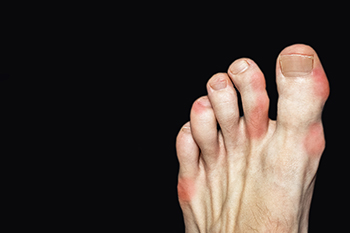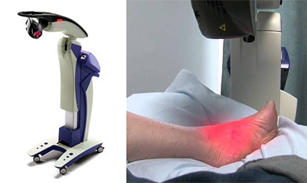Items filtered by date: November 2022
What Is the Forefoot?

Understanding the biomechanics of the human foot can be exceedingly helpful to individuals seeking to improve their ability to care for their feet. One important biomechanical concept to understand about the feet is how the forefoot functions. The forefoot is described as encompassing the ligaments, muscles, and metatarsal bones located at the front part of the foot. Also within the forefoot are the phalanges, also known as toe bones. There are many other important bones and entities that make up the forefoot and serve important functions. For example, the sesamoid bones located underneath the base of the big toe joint are also found within the forefoot. Certain afflictions of the foot can have a particular impact on the forefoot. Namely, sesamoiditis, toe pain, hammertoe, and claw toe all primarily affect the area. For more information about the forefoot, contact a podiatrist today.
If you have any concerns about your feet, contact Dr. Ronald Sheppard from Warren-Watchung Podiatry Center. Our doctor can provide the care you need to keep you pain-free and on your feet.
Biomechanics in Podiatry
Podiatric biomechanics is a particular sector of specialty podiatry with licensed practitioners who are trained to diagnose and treat conditions affecting the foot, ankle and lower leg. Biomechanics deals with the forces that act against the body, causing an interference with the biological structures. It focuses on the movement of the ankle, the foot and the forces that interact with them.
A History of Biomechanics
- Biomechanics dates back to the BC era in Egypt where evidence of professional foot care has been recorded.
- In 1974, biomechanics gained a higher profile from the studies of Merton Root, who claimed that by changing or controlling the forces between the ankle and the foot, corrections or conditions could be implemented to gain strength and coordination in the area.
Modern technological improvements are based on past theories and therapeutic processes that provide a better understanding of podiatric concepts for biomechanics. Computers can provide accurate information about the forces and patterns of the feet and lower legs.
Understanding biomechanics of the feet can help improve and eliminate pain, stopping further stress to the foot.
If you have any questions please feel free to contact one of our offices located in Marlboro and Watchung, NJ . We offer the newest diagnostic and treatment technologies for all your foot and ankle needs.
Stretch to Relieve Achilles Tendon Pain

The Achilles tendon is the strongest tendon in the body and connects the back of the heel to the calf muscle. It is partially responsible for lifting the heel when walking, running, and jumping. Injuring the Achilles tendon can make walking or exercising painful. Achilles tendonitis or an Achilles tendon rupture are the most common injuries involving this tendon. Such injuries can cause swelling, tenderness, and tightness in the area, particularly upon waking in the morning. One might limp after sustaining such an injury. These injuries may happen from overuse, forgetting to warm up before exercise, or wearing ill-fitting, non-supportive footwear. Resting and stretching are important for recovery. A daily runner’s stretch or a calf stretch targets the Achilles tendon and will help to promote healing. For this stretch, one puts their hands against a wall and lunges forward, with the leg with the sore Achilles tendon behind them. As much pressure as possible should be used for a nice stretch, making sure to avoid pain. This stretch should be held for 30 seconds and repeated three times. If you sustain an injury to your Achilles tendon, visit a podiatrist who can evaluate the injury and provide effective treatment, including recommendations for additional targeted stretching exercises.
Achilles tendon injuries need immediate attention to avoid future complications. If you have any concerns, contact Dr. Ronald Sheppard of Warren-Watchung Podiatry Center. Our doctor can provide the care you need to keep you pain-free and on your feet.
What Is the Achilles Tendon?
The Achilles tendon is a tendon that connects the lower leg muscles and calf to the heel of the foot. It is the strongest tendon in the human body and is essential for making movement possible. Because this tendon is such an integral part of the body, any injuries to it can create immense difficulties and should immediately be presented to a doctor.
What Are the Symptoms of an Achilles Tendon Injury?
There are various types of injuries that can affect the Achilles tendon. The two most common injuries are Achilles tendinitis and ruptures of the tendon.
Achilles Tendinitis Symptoms
- Inflammation
- Dull to severe pain
- Increased blood flow to the tendon
- Thickening of the tendon
Rupture Symptoms
- Extreme pain and swelling in the foot
- Total immobility
Treatment and Prevention
Achilles tendon injuries are diagnosed by a thorough physical evaluation, which can include an MRI. Treatment involves rest, physical therapy, and in some cases, surgery. However, various preventative measures can be taken to avoid these injuries, such as:
- Thorough stretching of the tendon before and after exercise
- Strengthening exercises like calf raises, squats, leg curls, leg extensions, leg raises, lunges, and leg presses
If you have any questions please feel free to contact one of our offices located in Marlboro and Watchung, NJ . We offer the newest diagnostic tools and technology to treat your foot and ankle needs.
Arthritis Can Cause Pain in the Feet and Ankles
Types of Foot Surgery

The feet are a complicated part of our bodies. Each foot consists of 26 bones, 33 joints, and many tendons, ligaments, and muscles. A variety of conditions can affect the feet and cause discomfort, which can limit mobility. At times things happen to change the structure and mechanics of the foot and surgery may be required. Foot surgery is typically considered when more conservative approaches do not work. It is often done to reduce pain, correct a deformity, or restore foot functioning. Some examples of foot surgery include bunion surgery, hammertoe surgery, and heel surgery. If you suffer from foot pain that is not relieved by rest or a change of shoes, see a podiatrist for an evaluation and treatment. Foot surgery can usually be prevented if problems are treated in a timely manner.
Foot surgery is sometimes necessary to treat a foot ailment. To learn more, contact Dr. Ronald Sheppard of Warren-Watchung Podiatry Center. Our doctor will assist you with all of your foot and ankle needs.
When Is Surgery Necessary?
Foot and ankle surgery is generally reserved for cases in which less invasive, conservative procedures have failed to alleviate the problem. Some of the cases in which surgery may be necessary include:
- Removing foot deformities like bunions and bone spurs
- Severe arthritis that has caused bone issues
- Cosmetic reconstruction
What Types of Surgery Are There?
The type of surgery you receive will depend on the nature of the problem you have. Some of the possible surgeries include:
- Bunionectomy for painful bunions
- Surgical fusion for realignment of bones
- Neuropathy decompression surgery to treat nerve damage
Benefits of Surgery
Although surgery is usually a last resort, it can provide more complete pain relief compared to non-surgical methods and may allow you to finally resume full activity.
Surgical techniques have also become increasingly sophisticated. Techniques like endoscopic surgery allow for smaller incisions and faster recovery times.
If you have any questions please feel free to contact one of our offices located in Marlboro and Watchung, NJ . We offer the newest diagnostic and treatment technologies for all your foot and ankle needs.
Types of Foot Surgery

The feet are a complicated part of our bodies. Each foot consists of 26 bones, 33 joints, and many tendons, ligaments, and muscles. A variety of conditions can affect the feet and cause discomfort, which can limit mobility. At times things happen to change the structure and mechanics of the foot and surgery may be required. Foot surgery is typically considered when more conservative approaches do not work. It is often done to reduce pain, correct a deformity, or restore foot functioning. Some examples of foot surgery include bunion surgery, hammertoe surgery, and heel surgery. If you suffer from foot pain that is not relieved by rest or a change of shoes, see a podiatrist for an evaluation and treatment. Foot surgery can usually be prevented if problems are treated in a timely manner.
Foot surgery is sometimes necessary to treat a foot ailment. To learn more, contact Dr. Ronald Sheppard of Warren-Watchung Podiatry Center. Our doctor will assist you with all of your foot and ankle needs.
When Is Surgery Necessary?
Foot and ankle surgery is generally reserved for cases in which less invasive, conservative procedures have failed to alleviate the problem. Some of the cases in which surgery may be necessary include:
- Removing foot deformities like bunions and bone spurs
- Severe arthritis that has caused bone issues
- Cosmetic reconstruction
What Types of Surgery Are There?
The type of surgery you receive will depend on the nature of the problem you have. Some of the possible surgeries include:
- Bunionectomy for painful bunions
- Surgical fusion for realignment of bones
- Neuropathy decompression surgery to treat nerve damage
Benefits of Surgery
Although surgery is usually a last resort, it can provide more complete pain relief compared to non-surgical methods and may allow you to finally resume full activity.
Surgical techniques have also become increasingly sophisticated. Techniques like endoscopic surgery allow for smaller incisions and faster recovery times.
If you have any questions please feel free to contact one of our offices located in Marlboro and Watchung, NJ . We offer the newest diagnostic and treatment technologies for all your foot and ankle needs.
Can Gout Be Prevented?

People who experience gout often have severe pain and discomfort. It is a form of arthritis that affects the joints in the big toe. The pain comes from inflammation that occurs in these joints and is often debilitating. Gout attacks may occur due to genetics or consuming specific foods. These foods include red meat, organ meat, shellfish, and alcoholic beverages. Existing medical conditions like high blood pressure, diabetes, or kidney disorders may also contribute to the onset of gout. There are effective prevention techniques that may help to reduce gout episodes. Incorporating a gentle exercise routine and changing eating habits that can accommodate healthy foods are generally successful in reducing further attacks. If you have had one or several bouts of gout, it is strongly advised that you are under the care of a podiatrist who can help you manage this painful condition.
Gout is a foot condition that requires certain treatment and care. If you are seeking treatment, contact Dr. Ronald Sheppard from Warren-Watchung Podiatry Center. Our doctor will treat your foot and ankle needs.
What Is Gout?
Gout is a type of arthritis caused by a buildup of uric acid in the bloodstream. It often develops in the foot, especially the big toe area, although it can manifest in other parts of the body as well. Gout can make walking and standing very painful and is especially common in diabetics and the obese.
People typically get gout because of a poor diet. Genetic predisposition is also a factor. The children of parents who have had gout frequently have a chance of developing it themselves.
Gout can easily be identified by redness and inflammation of the big toe and the surrounding areas of the foot. Other symptoms include extreme fatigue, joint pain, and running high fevers. Sometimes corticosteroid drugs can be prescribed to treat gout, but the best way to combat this disease is to get more exercise and eat a better diet.
If you have any questions please feel free to contact one of our offices located in Marlboro and Watchung, NJ . We offer the newest diagnostic and treatment technologies for all your foot and ankle needs.
Pros of Laser Treatment for Toenail Fungus

Toenail fungus is an ailment that affects many people worldwide. It is a contagious fungal infection that can happen from using public swimming pools, shower room floors, and locker rooms. The noticeable signs that are generally seen with this common ailment can consist of yellowing toenails, possibly becoming brittle, and falling off. It can be unsightly, and many people are self-conscious of their feet, especially during the warmer months when flip-flops are worn. There is a possible remedy that patients can take advantage of, and this is referred to as laser treatment for toenail fungus. It is done by targeting a laser directly into the nail bed and is generally painless. There are advantages to having this type of treatment performed, including destroying the fungus without interfering with the surrounding skin, and there are typically no side effects. Research has shown there is a high percentage rate of this type of treatment being effective. If you have toenail fungus and are interested in learning about laser treatment, please confer with a podiatrist who can effectively perform this procedure.
Laser treatment can be an effective way to get rid of toenail fungus. If you have any questions about laser treatment, consult with Dr. Ronald Sheppard from Warren-Watchung Podiatry Center. Our doctor will assess your condition and provide you with quality treatment for fungal nails.
What Are Toenail Fungal Infections?
Onychomycosis, or fungal infection of the nail, is a relatively common and non-serious condition. Around 10 percent of U.S. citizens are afflicted with fungal nails. Common forms of fungus that infect the nail include dermatophytes, yeasts, and molds.
Symptoms of Toenail Fungal Infections Include:
- Nail thickening
- Brittleness of the nail
- Discoloration of the nail
Diagnosis for Fungal Nails
Fungal infections are diagnosed by fungal culture and microscopy. This will rule out any other conditions such as nail trauma, psoriasis, lichen planus, and onychogryphosis.
What Is Laser Treatment?
Laser treatment is a non-invasive, safe, quick, and painless procedure that uses the heat from a laser to kill fungus in the nail. Each infected nail is targeted with a laser for several minutes. The treatment is usually utilized several different times over a select period. During this time, a podiatrist will keep an eye on the infection.
If you have any questions, please feel free to contact one of our offices located in Marlboro and Watchung, NJ . We offer the newest diagnostic and treatment technologies for all your foot care needs.
Pros of Laser Treatment for Toenail Fungus

Toenail fungus is an ailment that affects many people worldwide. It is a contagious fungal infection that can happen from using public swimming pools, shower room floors, and locker rooms. The noticeable signs that are generally seen with this common ailment can consist of yellowing toenails, possibly becoming brittle, and falling off. It can be unsightly, and many people are self-conscious of their feet, especially during the warmer months when flip-flops are worn. There is a possible remedy that patients can take advantage of, and this is referred to as laser treatment for toenail fungus. It is done by targeting a laser directly into the nail bed and is generally painless. There are advantages to having this type of treatment performed, including destroying the fungus without interfering with the surrounding skin, and there are typically no side effects. Research has shown there is a high percentage rate of this type of treatment being effective. If you have toenail fungus and are interested in learning about laser treatment, please confer with a podiatrist who can effectively perform this procedure.
Laser treatment can be an effective way to get rid of toenail fungus. If you have any questions about laser treatment, consult with Dr. Ronald Sheppard from Warren-Watchung Podiatry Center. Our doctor will assess your condition and provide you with quality treatment for fungal nails.
What Are Toenail Fungal Infections?
Onychomycosis, or fungal infection of the nail, is a relatively common and non-serious condition. Around 10 percent of U.S. citizens are afflicted with fungal nails. Common forms of fungus that infect the nail include dermatophytes, yeasts, and molds.
Symptoms of Toenail Fungal Infections Include:
- Nail thickening
- Brittleness of the nail
- Discoloration of the nail
Diagnosis for Fungal Nails
Fungal infections are diagnosed by fungal culture and microscopy. This will rule out any other conditions such as nail trauma, psoriasis, lichen planus, and onychogryphosis.
What Is Laser Treatment?
Laser treatment is a non-invasive, safe, quick, and painless procedure that uses the heat from a laser to kill fungus in the nail. Each infected nail is targeted with a laser for several minutes. The treatment is usually utilized several different times over a select period. During this time, a podiatrist will keep an eye on the infection.
If you have any questions, please feel free to contact one of our offices located in Marlboro and Watchung, NJ . We offer the newest diagnostic and treatment technologies for all your foot care needs.

